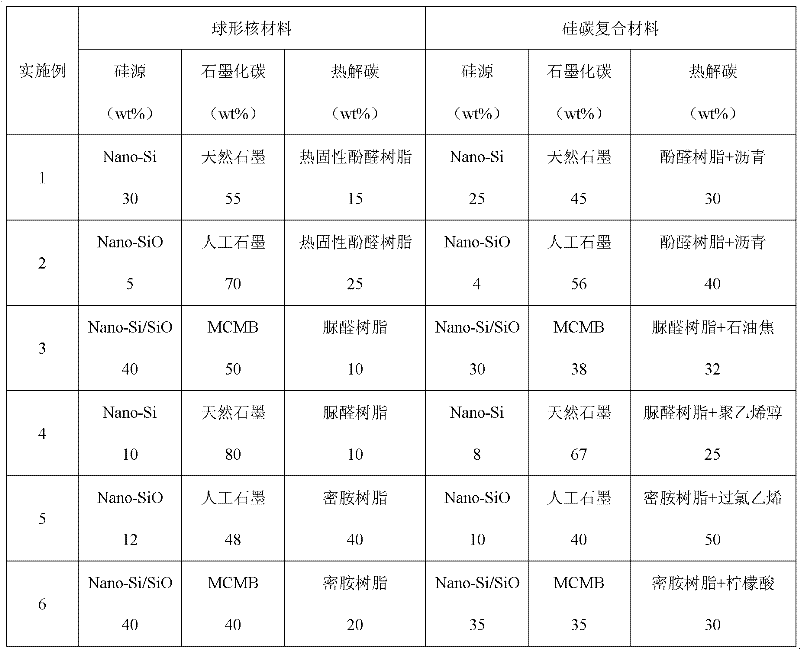Lithium ion battery composite anode material and preparation method thereof
A technology for lithium-ion batteries and negative electrode materials, applied to battery electrodes, circuits, electrical components, etc., can solve the problems of material structure damage, loss of electrical contact, capacity attenuation, etc., and achieve high tap density, high degree of practicality, and method simple and easy effects
- Summary
- Abstract
- Description
- Claims
- Application Information
AI Technical Summary
Problems solved by technology
Method used
Image
Examples
Embodiment 1
[0032] 1) Preparation of nuclear material by spraying once: add thermosetting phenolic resin (according to the content of pyrolytic carbon in the spherical nuclear material after sintering is 15wt%) into an appropriate amount of absolute ethanol, magnetically stir to form a solution with a certain viscosity, and then add nano Silicon powder (Nano-Si, according to the mass ratio of silicon / carbon in the spherical core material after sintering 3:7) and 8wt% polyethylene glycol dispersant, ultrasonically plus mechanical stirring for 1h, and then according to the natural stone in the spherical core material after sintering The ink content is 55wt%, adding natural graphite to disperse for 2 hours, spraying and drying the uniformly dispersed suspension at 170-200°C once to obtain the spherical core material.
[0033]2) Secondary spraying-sintering preparation of silicon-carbon composite negative electrode material: adding pitch (according to the total content of pyrolytic carbon afte...
Embodiment 2
[0036] 1) Prepare the spherical core material by spraying once: add thermosetting phenolic resin (according to the content of pyrolytic carbon in the spherical core material after sintering is 25wt%) into an appropriate amount of absolute ethanol, stir magnetically to form a solution with a certain viscosity, and then add Nano silicon monoxide powder (Nano-SiO, according to the mass ratio of silicon / carbon in the spherical core material after sintering: 1:19) and 0.5wt% polyammonium methacrylate dispersant, ultrasonic plus mechanical stirring for 0.5h, and then according to sintering The content of artificial graphite in the final spherical core material is 70wt%, adding artificial graphite to disperse for 1 hour, spraying and drying the uniformly dispersed suspension at 180-210° C. to obtain the spherical core material.
[0037] 2) Preparation of silicon-carbon composite negative electrode material by secondary spraying and sintering: add pitch (according to the total content ...
Embodiment 3
[0040] 1) Preparation of spherical core material by spraying once: add urea-formaldehyde resin (according to the content of pyrolytic carbon in the spherical core material after sintering is 10wt%) into an appropriate amount of deionized water, magnetically stir to form a solution with a certain viscosity, and then add nano-silicon The mixture with silicon monoxide (Nano-Si / SiO, according to the mass ratio of silicon / carbon in the spherical core material after sintering is 4:6) and 10wt% polyethylene glycol dispersant, ultrasonic plus mechanical stirring for 1h, and then according to sintering The content of graphitized mesocarbon microspheres (MCMB) in the spherical core material is 50wt%, and the graphitized mesocarbon microspheres are added to disperse for 2 hours, and the uniformly dispersed suspension is spray-dried once at 120-150°C to obtain a spherical nuclear material.
[0041] 2) Secondary spraying-sintering preparation of silicon-carbon composite negative electrode ...
PUM
| Property | Measurement | Unit |
|---|---|---|
| Particle size | aaaaa | aaaaa |
| Particle size | aaaaa | aaaaa |
Abstract
Description
Claims
Application Information
 Login to View More
Login to View More - R&D
- Intellectual Property
- Life Sciences
- Materials
- Tech Scout
- Unparalleled Data Quality
- Higher Quality Content
- 60% Fewer Hallucinations
Browse by: Latest US Patents, China's latest patents, Technical Efficacy Thesaurus, Application Domain, Technology Topic, Popular Technical Reports.
© 2025 PatSnap. All rights reserved.Legal|Privacy policy|Modern Slavery Act Transparency Statement|Sitemap|About US| Contact US: help@patsnap.com


